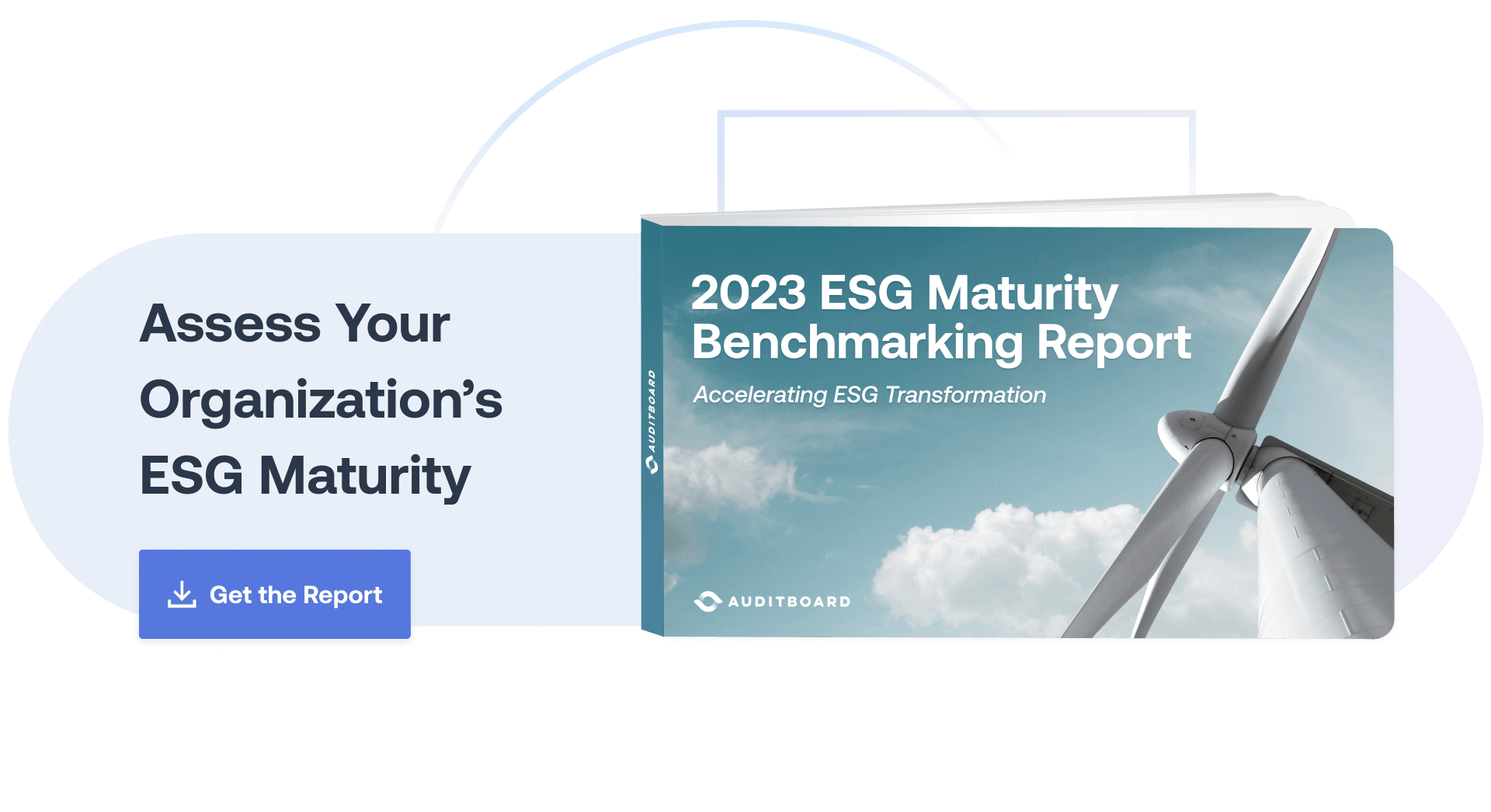
August 24, 2023 • 8 min read
Top 5 Takeaways From the 2023 ESG Maturity Benchmarking Report



Claire Feeney & Arsh Kaur & Ashlee Holt
In a business environment that is becoming more finely attuned to the concerns of sustainability-focused stakeholders, consumer expectations, and regulations — including the SEC’s proposed climate disclosure rules — companies are assuming a proactive stance in spearheading their initiatives related to environmental, social, and governance (ESG) matters.
Yet, despite growing demand from investors and stakeholders for commitment to ESG, many organizations face obstacles when it comes to ensuring they are accurately capturing and reporting ESG data and developing effective ESG risk management practices. As a result, ESG maturity can vary widely from company to company.
In AuditBoard’s inaugural ESG Maturity Benchmarking Report: Accelerating ESG Transformation, we sought to explore the state of ESG maturity in 2023. To help businesses seeking to mature their ESG efforts and practices, we’ve broken ESG down into four fundamental areas of competency in order to assess the maturity of an organization’s ESG program:
- Investment and processes
- Breadth and depth
- Reporting and disclosures
- Governance and controls
Download the full report here, and continue reading for our top 5 takeaways from the 2023 ESG Maturity Benchmarking Report: Accelerating ESG Transformation.
Takeaway #1: Of the four areas of ESG competency, survey respondents displayed the most mature scores in “Investment & Processes.”
65% of our respondents scored in the Strategic (33%) and Groundbreaking (32%) tiers for ESG Investment and Processes. Respondents in these tiers who disclosed their industry were predominantly represented by the Industrial and Finance & Insurance sectors, which reflects the heavily regulated nature of both industries.
Despite these positive headcount numbers, there is significant room for growth beyond ESG titles and department optics.
- 46% of our respondents reported that there is no dedicated budget allocated for ESG.
- Among those with an ESG budget, only 9% have a budget allocated for ESG technology.
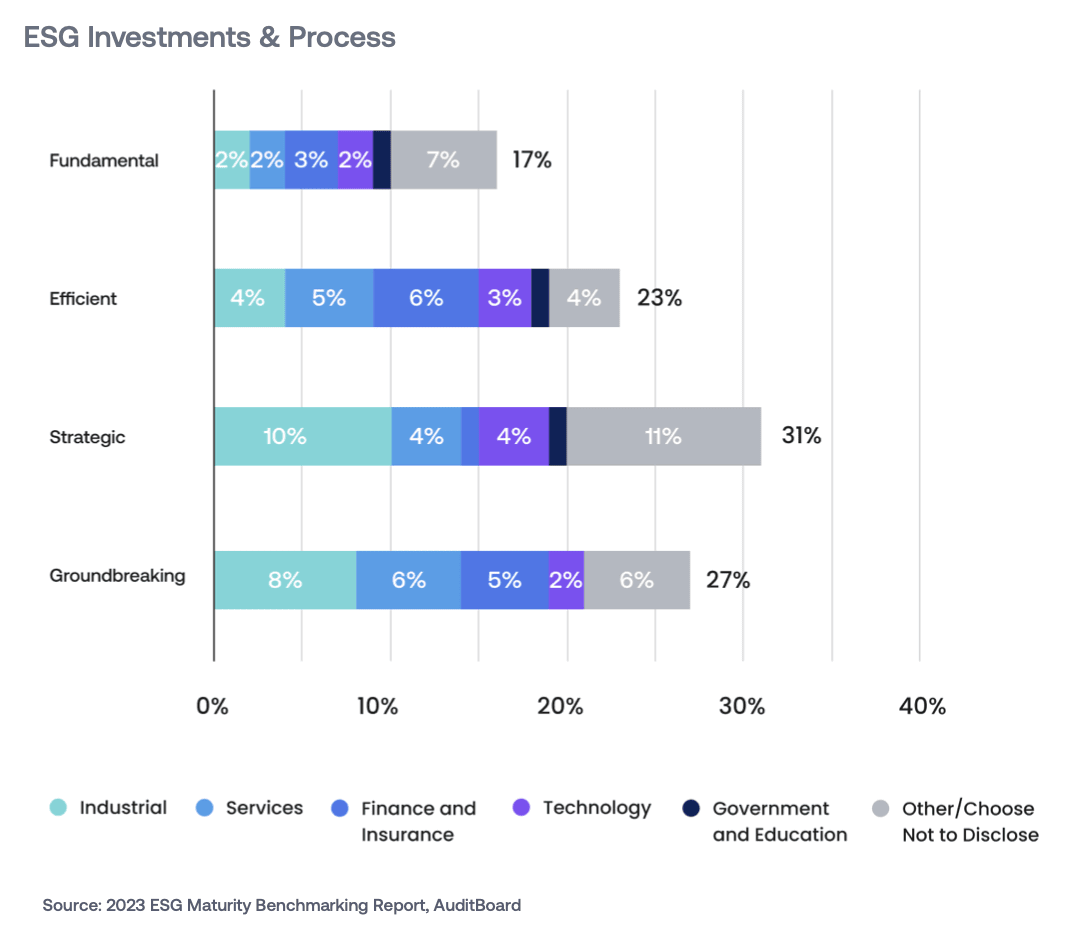
Takeaway #2: The most tracked topics in each ESG category were: Climate change and carbon emissions (72%), Gender and diversity (75%), and Board composition (66%).
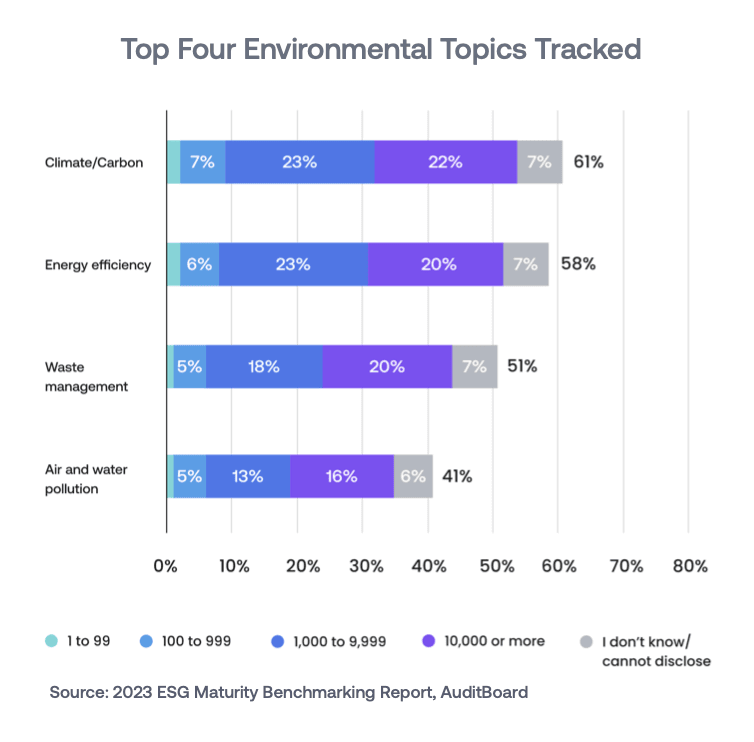
Depending on their industry and geographic region, businesses tracked a wide range of ESG topics, highlighting that ESG is not a one-size-fits-all risk category.
Smaller organizations (less than 1,000 employees) tend to track climate change & carbon emissions (Environmental), human rights, customer satisfaction, data protection/privacy (Social), and executive compensation (Governance).
This indicates that these may be areas where many organizations begin their ESG initiatives.
Takeaway #3: Of the four areas of ESG competency, survey respondents displayed the lowest maturity in Reporting and Disclosures.
In Reporting and Disclosures, nearly half of respondents scored in the lowest “Fundamental” level of maturity, only 9% demonstrated Strategic maturity, and none scored in the Groundbreaking category — the highest level of maturity.
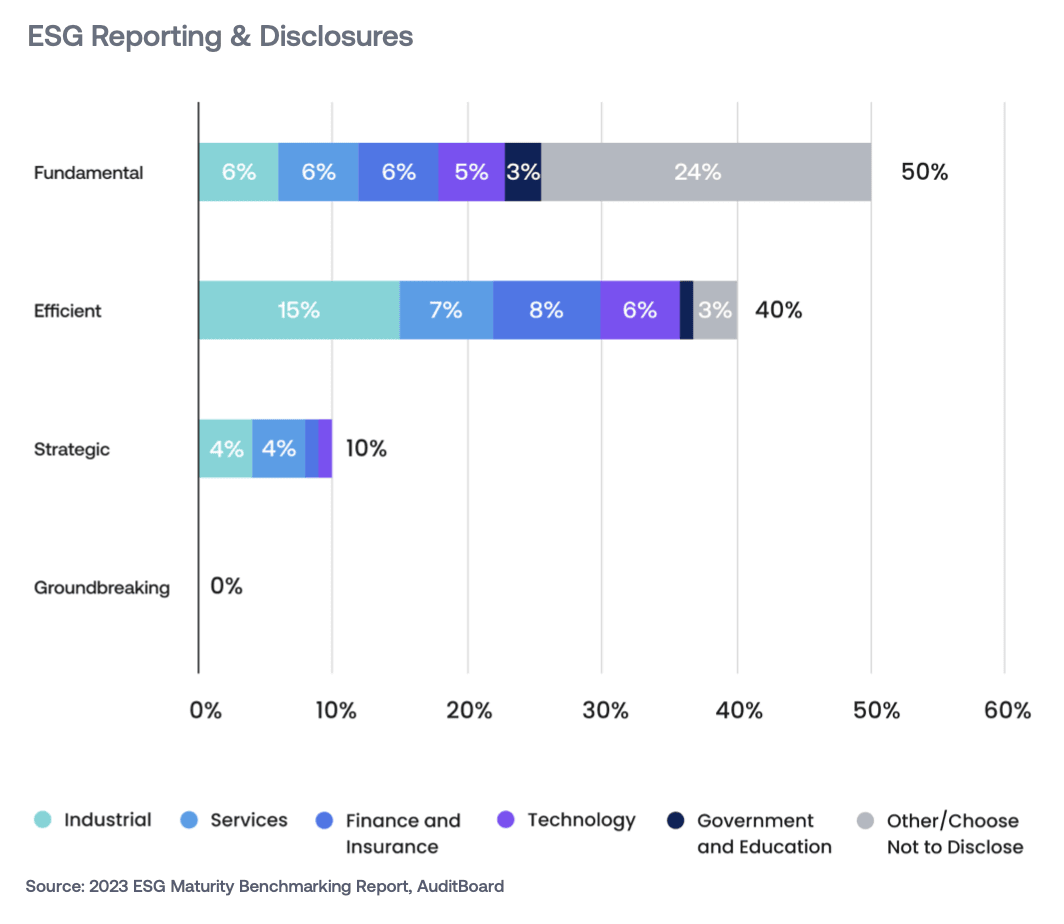
The rising prevalence of greenwashing emphasizes the need to have strong ESG data verification mechanisms in place. As it stands currently:
- Nearly 24% of respondents don’t collect any evidence to support their ESG metrics, while 42% collect evidence — but only for a portion of ESG metrics.
- Only 10% of our respondents demonstrate Strategic maturity in reporting and disclosures and 0% scored in the Groundbreaking category — representing significant room for growth and improvement.
- While 72% of our respondents track at least some ESG data metrics across their physical locations, offices, and manufacturing plants, only 17% centralize ESG data collected on a regular basis and make it accessible to internal stakeholders.
- Only 31% of respondents perform third-party assurance on their ESG data, representing room for growth in data verification as well.
These low maturity scores in Reporting and Disclosures indicate room for improvement in ESG data verification and reporting practices.
Takeaway #4: ESG is not being included as part of ERM in a strategic way in many organizations.
Nearly 40% of our respondents don’t include ESG risks in their ERM strategy, indicating that ESG is not yet embedded as extensively in organizations as it has the potential to be.
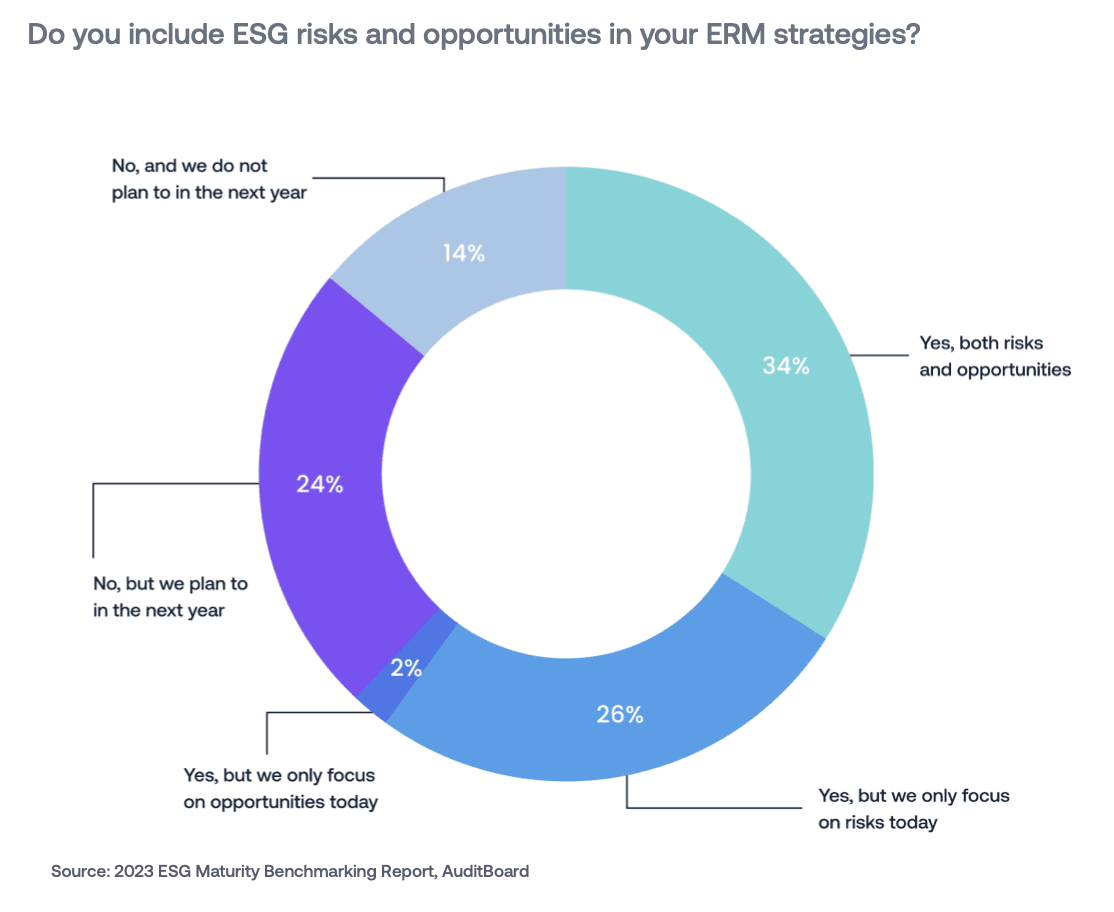
While 60% of our respondents are considering ESG risks in their ERM strategies, only 33% are focused on both ESG risks and opportunities. The emphasis on ESG risks indicates that there are likely areas of ESG not being surfaced today that present material business opportunities.
Nearly 45% of our survey respondents have performed an ESG materiality assessment within the last 12 months, yet 35% of our respondents have not performed a materiality assessment at all — highlighting an easy area to begin taking action in.
Takeaway #5: The majority of respondents have little to no governance or oversight over their ESG programs today. Two-thirds of our survey respondents have not implemented ESG controls.
Over one-third of our respondents report being in compliance or planning to comply with the SEC’s proposed climate disclosure rule — yet 74% of our respondents identified themselves as working at public companies that will be required to comply when the rule is formalized and adopted. Moreover, while private companies may not be preparing 10-Ks, they may be asked by customers or partners to disclose emissions data related to their supply chain ecosystem that could potentially have an impact on their business.
Two-thirds of our survey respondents have not implemented ESG controls, highlighting a low state of maturity in ESG data governance. Once the proposed SEC climate disclosures become formalized, public companies will be required to have ESG controls in place to streamline the process of obtaining third-party assurance for compliance with the new rules.
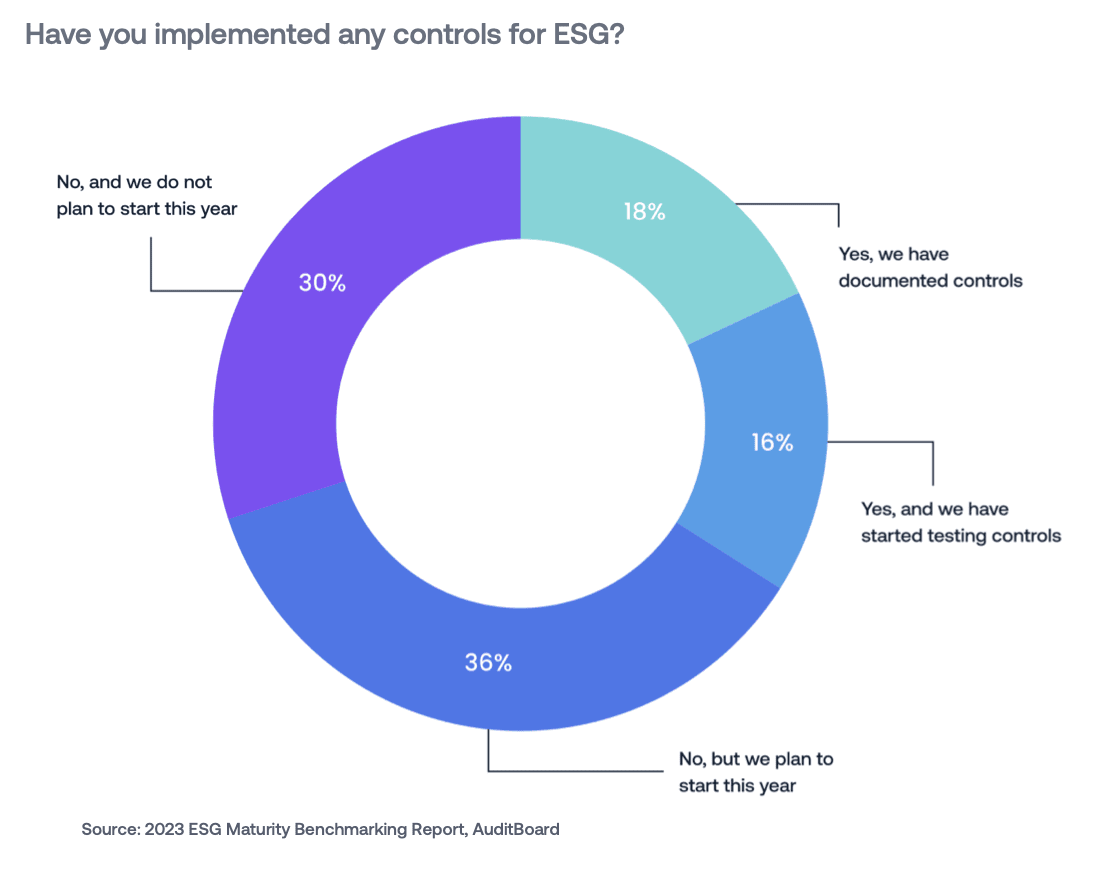
The journey towards ESG maturity is an ongoing one that requires dedication, continuous improvement, and a commitment to creating long-lasting positive impact. To view the full report and learn more about maturing your ESG maturity, download the full 2023 ESG Maturity Benchmarking Report: Accelerating ESG Transformation.
About the authors

Claire Feeney is a Senior Product Marketing Manager at AuditBoard focused on ESG and RiskOversight. In her role, she helps support organizations in transforming their enterprise risk management and sustainability programs. Prior to joining AuditBoard, Claire worked in product marketing at OneTrust, VMware, and Infor. Connect with Claire on LinkedIn.

Arsh Kaur is a Principal Product Manager at AuditBoard focused on ESG Product Strategy. Prior to joining AuditBoard, Arsh worked in product management at Procore Technologies. Connect with Arsh on LinkedIn.

Ashlee Holt is a Senior Manager of Implementation at AuditBoard. A seasoned risk and audit leader with 16+ years of experience at organizations including Regions Financial Corporation and Focal Point Data Risk (a CDW company), where she provided audit and risk advisory services across a wide array of industries. Connect with Ashlee on LinkedIn.
You may also like to read


NIST CSF 2.0: What IT compliance managers need to know in 2025

Building resilience with IAM: Unifying access, risk, and compliance

ISO 27001 risk assessment: A practical guide for IT compliance managers

NIST CSF 2.0: What IT compliance managers need to know in 2025

Building resilience with IAM: Unifying access, risk, and compliance
Discover why industry leaders choose AuditBoard
SCHEDULE A DEMO




